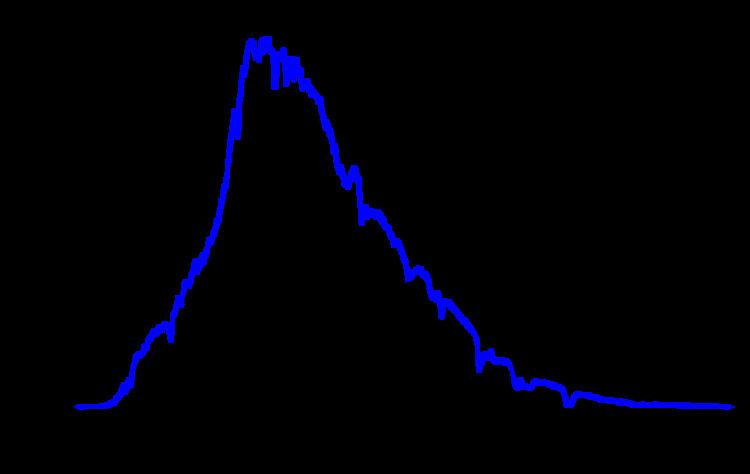 | ||
Diffuse sky radiation is solar radiation reaching the Earth's surface after having been scattered from the direct solar beam by molecules or suspensoids in the atmosphere. It is also called skylight, diffuse skylight, or sky radiation and is the reason for changes in the color of the sky. Of the total light removed from the direct solar beam by scattering in the atmosphere (approximately 25% of the incident radiation when the sun is high in the sky, depending on the amount of dust and haze in the atmosphere), about two-thirds ultimately reaches the earth as diffuse sky radiation. When the sun is at the zenith in a cloudless sky, with 1361 W/m2 above the atmosphere, direct sunlight is about 1050 W/m2, and total insolation about 1120 W/m2. This implies that under these conditions the diffuse radiation is only about 70 W/m2 out of the original 1361 W/m2.
Contents
The dominant radiative scattering processes in the atmosphere (Rayleigh scattering and Mie scattering) are elastic in nature, by which light can be deviated from its path without being absorbed and with no change in wavelength.
Color
The sunlit sky is blue because air scatters short-wavelength light more than longer wavelengths. Since blue light is at the short-wavelength end of the visible spectrum, it is more strongly scattered in the atmosphere than long-wavelength red light. The result is that when looking toward parts of the sky other than the sun, human eye perceives them to be blue. The color perceived is similar to that obtained by a monochromatic blue of a wavelength of 474–476 nm mixed with white light, i.e., an unsaturated blue light.
Near sunrise and sunset, most of the sunlight arrives nearly tangentially to the Earth's surface; thus, the light's path through the atmosphere is so long that much of the blue and even green light is scattered out along the way, leaving the sun rays and the clouds it illuminates red. Therefore, when looking at the sunset and sunrise, we see the colour red more than the other colors.
Scattering and absorption are major causes of the attenuation of radiation by the atmosphere. Scattering varies as a function of the ratio of the particle diameter to the wavelength of the radiation. When this ratio is less than about one-tenth, Rayleigh scattering occurs. In this case the scattering coefficient varies inversely with the fourth power of the wavelength. At larger ratios, scattering varies in a complex fashion, described for spherical particles by the Mie theory; the laws of geometric optics begin to apply at a ratio of the order of 10.
In the example of the sky at the zenith, it is blue during broad daylight due to Rayleigh scattering involving diatomic gases (N
2, O
2). Near sunset and especially during twilight, ozone (O
3) absorption significantly contributes to maintaining the sky's blue color.
Neutral points
There are four commonly detectable points of zero polarization of diffuse sky radiation (known as neutral points) lying along the vertical circle through the sun.
Under an overcast sky
There is essentially no direct sunlight under an overcast sky, so all light is then diffuse sky radiation. The flux of light is not very wavelength dependent because the cloud droplets are larger than the light's wavelength and scatter all colors approximately equally. The light passes through the translucent clouds in a manner similar to frosted glass. The intensity ranges (roughly) from 1⁄6 of direct sunlight for relatively thin clouds down to 1⁄1000 of direct sunlight under the extreme of thickest storm clouds.
As a part of total radiation
One of the equations for total solar radiation is:
where Hb is the beam radiation irradiance, Rb is the tilt factor for beam radiation, Hd is the diffuse radiation irradiance, Rd is the tilt factor for diffuse radiation and Hr is the tilt factor for reflected radiation.
Rb is given by:
where δ is the solar declination, Φ is the latitude, β is an angle from the horizontal and h is the solar hour angle.
Rd is given by:
and Rr by:
where ρ is the reflectivity of the surface.
